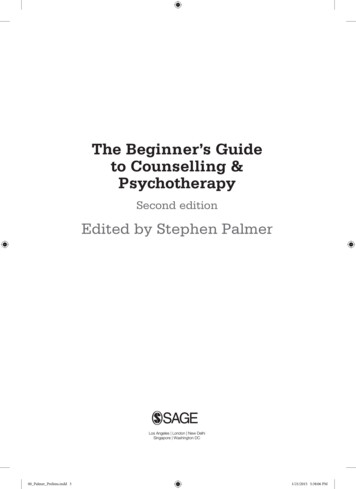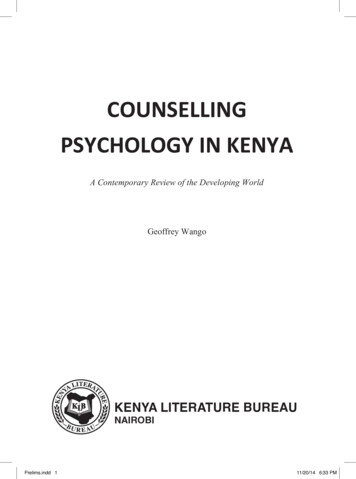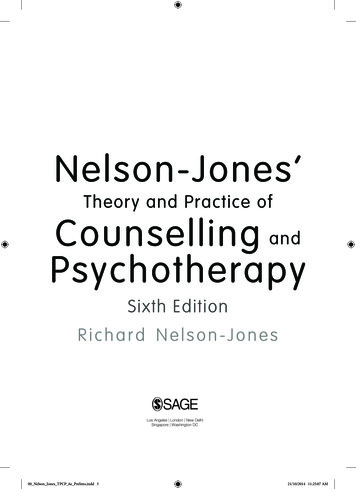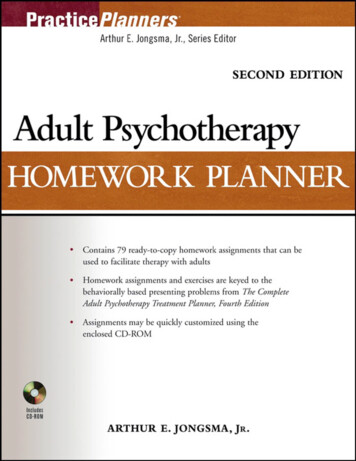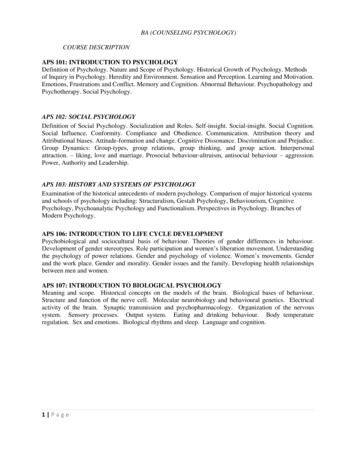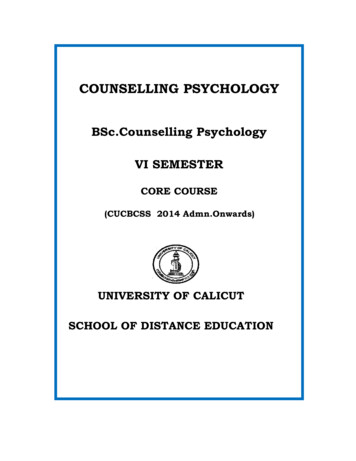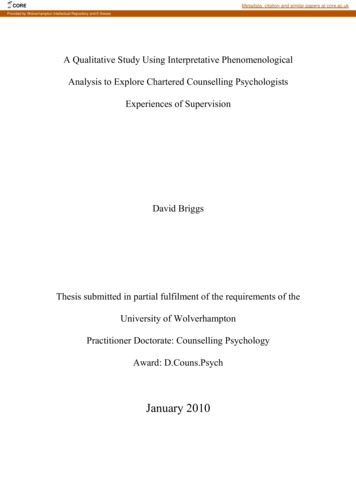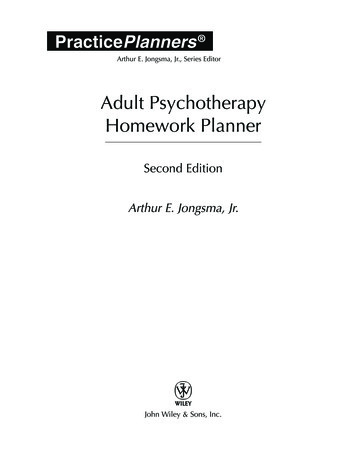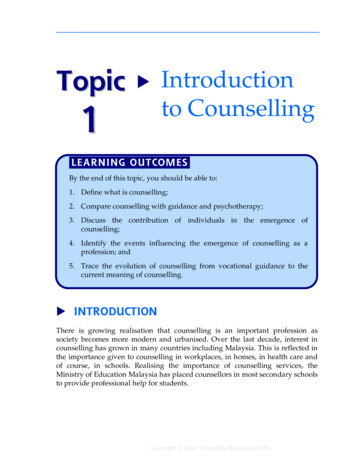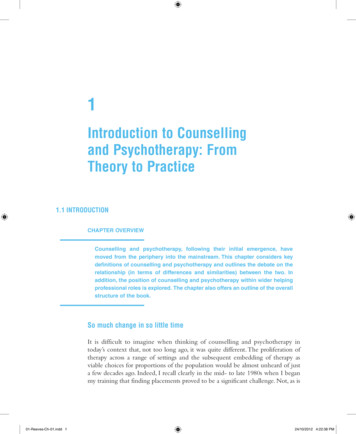
Transcription
1Introduction to Counsellingand Psychotherapy: FromTheory to Practice1.1 INTRODUCTIONCHAPTER OVERVIEWCounselling and psychotherapy, following their initial emergence, havemoved from the periphery into the mainstream. This chapter considers keydefinitions of counselling and psychotherapy and outlines the debate on therelationship (in terms of differences and similarities) between the two. Inaddition, the position of counselling and psychotherapy within wider helpingprofessional roles is explored. The chapter also offers an outline of the overallstructure of the book.So much change in so little timeIt is difficult to imagine when thinking of counselling and psychotherapy intoday’s context that, not too long ago, it was quite different. The proliferation oftherapy across a range of settings and the subsequent embedding of therapy asviable choices for proportions of the population would be almost unheard of justa few decades ago. Indeed, I recall clearly in the mid- to late 1980s when I beganmy training that finding placements proved to be a significant challenge. Not, as is01-Reeves-Ch-01.indd 124/10/2012 4:22:38 PM
2An Introduction to Counselling and Psychotherapythe case today, because of the number of people chasing the same opportunities,but rather because it was difficult to find counselling and psychotherapy in manysettings at all outside of independent practice or specialist environments. Therapyin primary and secondary care was very limited, with opportunities existingmostly in the third sector.A number of factors have led to change in the intervening years. They include:work by a number of professional bodies to communicate the benefits of counselling and psychotherapy; increasing acknowledgement of the importance ofmental health and the link between mental and physical wellbeing; a slow moveaway from a medication culture, with a population more willing perhaps toquestion the treatment they receive; an increasing evidence base demonstratingthe efficacy of the psychological therapies across a range of difficulties; a challenge(led by mental health charities) to the stigma of mental health distress and thepromotion of help-seeking; a higher profile of counselling and psychotherapy inthe media; and a change in policy, particularly around mental health, towards agreater involvement of service users and the increasing potency of the client/patient voice.When I qualified as a social worker and began working in adult mental healthsecondary care settings, psychiatry was still a very dominant force: the psychiatristwas rarely questioned and intervention for people experiencing acute and chronicmental health distress typically consisted of medication or in- and out-patient care.Over the intervening years the dominance of psychiatry has waned: the psychiatrist remains an important figure, but one who is now part of a mental health team.Nursing, social work, advocacy and psychology have become more prominent andhospital admission is seen very much as a last alternative. Advances in medicationhave given medical personnel greater treatment options and people experiencing difficulties have demanded alternatives to medication and hospitalisation. Counsellingand psychotherapy have increasingly come to be seen as a viable and beneficial alternative or addition to other forms of support. Therapy has moved from the peripheryinto the mainstream. In the process, it has further embedded itself into mainstreamculture, such as in films, music, literature, art and television and, in doing so, hasentered the public consciousness.This change has brought challenges. Counsellors and psychotherapists need tobe equipped by their training to work in a wider variety of contexts and to acquireskills and knowledge to meet a wide range of presenting issues. Each workingcontext demands its own level of competence, with therapists trained on genericcourses needing to undertake further training to equip them for their role. Withthis proliferation too comes the need to ensure that practice remains ethically andlegally pertinent, offering high levels of care and integrity to those accessing help.With a greater demand for innovative and effective treatments comes a necessity todemonstrate efficacy in the face of falling budgets and closing services. Counsellorsand psychotherapists need to develop competency as researcher-practitioners, or at01-Reeves-Ch-01.indd 224/10/2012 4:22:38 PM
Chapter 1 From Theory to Practice3least as competent critical consumers of research. The imperative is for counsellingand psychotherapy to clearly and unequivocally demonstrate a sound evidencebase for practice. We cannot just assume that what we do works: we need todemonstrate it in the language of commissioners, budget holders and policydevelopers. The development and implementation of benchmarking tools andoutcome measures demand that therapists find ways of integrating such tools intotheir day-to-day work with clients.The rapid development of technology too has made its inroads into the provisionof therapy. This has occurred not only in terms of record keeping, databases andtracking client demographic information, but also in the actual delivery of therapy,moving away from face-to-face contact and transporting therapy into a virtualworld of email, synchronous chat and message boards. Clients now, quite rightly,demand up-to-date information not just about the types of therapy on offer, butalso the form and nature of the delivery of the therapy they will receive. Theyhave become informed consumers, requesting specific therapies and particularinterventions.Counselling and psychotherapy: from theory to practiceThere is so much for new trainees to discover that it is quite impossible forcourses, however hard they try, to cover all that is needed. The place of supervisionis important here in helping new practitioners to make the link from theory topractice in both contextualising and understanding the lessons from direct workwith clients. The responsibility for self-direction in personal and professionaldevelopment is key too.When beginning to think about this book, I reflected on what was already available and where the gaps were between existing resources. There are a number ofexcellent introductory texts that help draw on research and academic learning toinspire new therapists. There are also some great texts that explore the acquisitionand development of skills. As a practitioner I have sought to write something thatcould accompany you from your earliest steps at the beginning of your training,into the practice placement, then on to the process of reflecting on how you begindirect work with clients. I have aimed too for the book, as your competence andexperience develops, to help link practice learning and theory and to explore thepossibility of employment and, finally, qualified practice. That is, I have wanted toproduce a book that would accompany you every step of the way – a bookwritten by a practitioner for new practitioners. I have tried to include everythingin here – including the kitchen sink! I have sought to include all those aspectsof practice that we consider, think about and reflect on.Though in the end I haven’tactually been able to include the sink, I hope that the book proves to be useful andthought-provoking and that it prompts further questions and discovery.01-Reeves-Ch-01.indd 324/10/2012 4:22:38 PM
4An Introduction to Counselling and PsychotherapyThe book as a whole: what’s in storeHere I want to offer a pen picture of each chapter so you can quickly see how thebook is structured, ‘signposting’ you to sections most relevant for your stage on thejourney into practice. The book is structured over three parts: Setting the Context(in which we will look at training, theories, settings, law and ethics); The Therapeutic Relationship (in which we will consider the types of problems we may workwith in sessions with clients and the management of the therapeutic relationship);and The Professional Self (in which we will consider key aspects of, and beyond,contact with clients that help determine accountable and professional practice).Chapter 1: Introduction to Counselling and PsychotherapyWell, you’re here already! This first chapter outlines definitions of counselling andpsychotherapy and how they are different and similar (and, trust me, that is no easytask!), before moving on to an overview of their development.The process of tracingthis emergence provides a helpful overview in locating today’s practice in a widerhistorical context. It is important to view the current situation in the context of itshistory and development – the past so often helps us make sense of the present.Part One: Setting the ContextChapter 2: Becoming a Counsellor or Psychotherapist: The Training JourneyThe next chapter examines all the factors that inform, shape, support and challenge the process of becoming a counsellor or psychotherapist, starting right at thevery beginning of training. While it is, without doubt, a fascinating and lifechanging process, it can also bring difficult challenges that you need to considerbefore you begin. Likewise, knowing what sort of training you are looking for, thecontext you might wish to work in when you qualify, as well as the multitude ofpractical considerations, all require commensurate thought.Chapter 3: Principal Counselling and Psychotherapy Approaches and SkillsHere I provide an overview of the main theories and models that inform contemporary counselling and psychotherapy. The chapter does not seek to provide anexhaustive list (given the estimated 450 models of therapy available!): instead, itfocuses on the key models and provides a checklist for each of the principal ideasand philosophical assumptions. Models include cognitive-behavioural approaches,the psychodynamic approaches, as well as the humanistic models. Additionally, thechapter considers current developments in counselling and psychotherapy thinking,including the emergence of models such as mindfulness-based cognitive-behaviouraltherapy and working pluralistically.01-Reeves-Ch-01.indd 424/10/2012 4:22:38 PM
Chapter 1 From Theory to Practice5Chapter 4: Professional Settings and OrganisationsThe sheer scope of working contexts and settings in which counselling and psychotherapy are found can be overwhelming. This chapter considers why and howthe setting in which counselling and psychotherapy take place is so important inshaping the form and nature of the therapy on offer, as well as how counsellingand psychotherapy ‘sit’ within a procedural and political frame and the importanceof your having an understanding of the policies that have particular influence ontheir setting and practice, including independent practice.Chapter 5: Law, Policy, Values and EthicsCounselling and psychotherapy operate within a legal framework and are informedby policy, yet are fundamentally rooted in strong values and ethics. This chapterlooks at how law and policy define what we do, but also how our values and ethicsas counsellors and psychotherapists shape and structure our thinking and approachto practice. Here we will consider how the soul of the therapeutic relationship isenlivened by our core beliefs.Part Two: The Therapeutic RelationshipChapter 6: Clients and Presenting IssuesClients present with a wide range of problems in counselling and psychotherapy,from struggles with worry and wellbeing, through to complex and long-standingmental health problems. Some clients will have a formal diagnosis of mental healthdistress, while others will not. Before we can critically reflect on diagnostic structures and labels (or reject them) we need to understand how they work so that wecan see problems in context. The problems explored in greater detail will include:anxiety and panic attacks; depression; post-traumatic stress; eating disorders; lossand bereavement; suicide and self-harm; sexual problems; psychosis; and personality disorders.Chapter 7: Managing Aspects of the Therapeutic RelationshipCounselling and psychotherapy are about beginning, structuring, contracting,maintaining and ending, and managing all aspects in between; the therapeutic process begins before the client ever enters the room. Here we will outline and exploreall these factors so that you can support your learning and offer your clients a safe,respectful and appropriate space for them to explore their difficulties.Chapter 8: Challenges in the Therapeutic RelationshipThere are a number of important areas integral to the therapeutic process that can alsopresent particular challenges to it, including: transference and countertransference;01-Reeves-Ch-01.indd 524/10/2012 4:22:39 PM
6An Introduction to Counselling and Psychotherapydependency; missed appointments and cancellations; clients who are resistant totherapy; self-disclosure; and getting ‘stuck’. While the chapter won’t be able to offera blueprint response applicable to all situations all of the time, having the confidenceto understand them as part of the therapeutic process, as opposed to outside of it,can help us work more effectively with them.Chapter 9: Working with Diversity and DifferenceIt is important that we acknowledge the diversity in human experience and howthat will be presented in counselling and psychotherapy sessions, including throughsexual orientation, gender, faith and spirituality, culture and disability. We mustchallenge the idea that there is a ‘one size fits all’ approach to therapy and reflecton and adapt our practice in accordance with our clients’ needs. This will involvequestioning our own underlying assumptions and stereotypes.Part Three: The Professional SelfChapter 10: Managing Professional ResponsibilitiesThere are a number of important skills and boundaries for us to consider that notonly facilitate the therapeutic relationship, but can also be important aspects of it.How we communicate with clients outside of sessions, keep our relationshipsappropriate and manage dual relationships (where we may have contact with clientsin other settings or roles) all demand commensurate skill. Likewise, whether or howto use touch as part of our work, how to check we continue to work within theboundaries of competency and, finally, how we take care of ourselves all demandtime and consideration.Chapter 11: Supervision and ConsultationSupervision is an integral part of what we do as counsellors and psychotherapistsand, in the UK, is an ethical requirement of practice. Here we will look at what ismeant by the term, offering definitions that help explore the different componentsof a successful supervisory relationship. The process begins with finding the rightsupervisor, and then includes how to contract, review and, eventually, end a supervisory relationship: all these aspects are considered fully.Chapter 12: Counselling, Psychotherapy and ResearchWe have already highlighted how, in moving from the periphery to the mainstream,counselling and psychotherapy need to demonstrate their efficacy not only to fundersand commissioners, but also (and most importantly perhaps) to those accessing helpat times of distress. We need to become at least a research-aware profession, if nota research-active one. Here we will consider some of the main skills required in01-Reeves-Ch-01.indd 624/10/2012 4:22:39 PM
Chapter 1 From Theory to Practice7critically evaluating research, as well as theories and ideas that might help us takethe first steps to becoming researchers.Chapter 13: Endings and the Next StepsLike all journeys, this one has an ending.This chapter will aim to prompt reflection to helpyou consider the process you have been through and look forward to what may be next.When we finish our training we step out into the world as qualified practitioners and aretasked with making important decisions about our personal and professional future.Thejourney from placement to practice is the point at which theory becomes alive, speculations become reality and the immense satisfaction that can be gained in meeting withanother to help them find their way through difficulty and disturbance becomes realised.I hope that you enjoy your journey as much as I am enjoying mine and that you will findthis book of benefit to you along the way. On the companion website I have made a shortvideo talking through the structure of the book, which you may want to watch.So, let’s begin .1.2 DEFINING COUNSELLING AND PSYCHOTHERAPYSECTION OUTLINEThere is much debate over the differences and similarities between ‘counselling’ and‘psychotherapy’ and this has vexed theorists, academics, practitioners and researchersfor some considerable time. This section explores the question of whether counsellingand psychotherapy are discrete disciplines or, in contrast, whether the overlap issufficient to render distinction irrelevant.There are always challenges in trying to define ‘counselling’ and ‘psychotherapy’as it inevitably and immediately leads into contentious territory about similarities and differences. If one writes about ‘counselling’, the risk is that thosepsychotherapists who see their role as different from counselling will disengage.Likewise, writing about ‘psychotherapy’ runs the risk of leaving a proportion ofcounsellors out in the cold.To write about ‘counselling and psychotherapy’, however, runs the risk of presuming they are two, distinct activities, while to use‘psychological therapies’ as a ‘catch-all’ phrase runs the risk of leaving everyoneout in the cold.These dilemmas present problems not only for textbook authors: imagine theimplications for delivery of services, regulation and accreditation, training and, mostimportantly, the confusion potential clients might experience when considering01-Reeves-Ch-01.indd 724/10/2012 4:22:39 PM
8An Introduction to Counselling and Psychotherapywhat services to access. Should they see a counsellor or a psychotherapist, and(they may ask) what’s the difference between the two anyway?Kanellakis and D’Aubyn (2010) undertook a study of the public’s perceptionof the titles of counsellor and psychotherapist. Four hundred and fifty membersof the UK public were interviewed by researchers and asked their thoughts about theterms ‘counsellor’,‘psychotherapist’ and ‘psychological therapist’: 30% thought the terms‘counsellor’ and ‘psychotherapist’ were almost identical, while 64% thought themsignificantly different. Only 24% thought the terms ‘psychotherapist’ and ‘psychological therapist’ were significantly different, while 66% thought them almostidentical. In this study the public’s perception was that ‘psychotherapist’ was muchcloser to ‘psychological therapist’ than to ‘counsellor’. Perhaps there is as much confusion in the public perception as there is within the professional field betweenthe different terms.DefinitionsThe British Association for Counselling and Psychotherapy (BACP, 2012) definescounselling and psychotherapy as:umbrella terms that cover a range of talking therapies. They are delivered bytrained practitioners who work with people over a short or long term to helpthem bring about effective change or enhance their wellbeing.The American Counseling Association (ACA, 2005, p. 4) says that counsellingencourage[s] client growth and development in ways that foster the interestand welfare of clients and promote formation of healthy relationships. Counselors actively attempt to understand the diverse cultural backgrounds of theclients they serve. Counselors also explore their own cultural identities andhow these affect their values and beliefs about the counseling process.Feltham (2012, p. 3) says of counselling and psychotherapy that they are:mainly, though not exclusively, listening-and-talking based methods of addressingpsychological and psychosomatic problems and change, including deep and prolonged human suffering, situational dilemmas, crises and developmental needs,and aspirations towards the realisation of human potential. In contrast to biomedical approaches, the psychological therapies operate largely without medication or other physical interventions and may be concerned not only with mentalhealth but with spiritual, philosophical, social and other aspects of living. Professional forms of counselling and psychotherapy are based on formal training whichencompasses attention to pertinent theory, clinical and/or micro-skills development, the personal development/theory of the trainee, and supervised practice.01-Reeves-Ch-01.indd 824/10/2012 4:22:39 PM
Chapter 1 From Theory to Practice9According to the United Kingdom Council of Psychotherapy (UKCP, 2012)psychotherapyaims to help clients gain insight into their difficulties or distress, establish agreater understanding of their motivation, and enable them to find moreappropriate ways of coping or bring about changes in their thinking andbehaviour. Psychotherapy involves exploring feelings, beliefs, thoughts andrelevant events, sometimes from childhood and personal history, in a structured way with someone trained to help you do it safely. Depending on thenature of [the] problem, therapy can be short or long term. Sessions can beprovided for adults, adolescents and children on a one-to-one basis, or forcouples, families and within groups whose members share similar problems.The British Psychological Society (BPS, 2005, pp. 1-2) states that counselling psychologydraws upon and seeks to develop phenomenological models of practice andenquiry in addition to that of traditional scientific psychology. It continues todevelop models of practice and research, which marry the scientific demandfor rigorous empirical enquiry with a firm value base grounded in the primacy of the counselling or psychotherapeutic relationship.These models seek:1 to engage with subjectivity and intersubjectivity, values and beliefs;2 to know empathically and to respect first person accounts as valid in theirown terms; to elucidate, interpret and negotiate between perceptions andworld views but not to assume the automatic superiority of any one wayof experiencing, feeling, valuing and knowing;3 to be practice led, with a research base grounded in professional practicevalues as well as professional artistry;4 to recognise social contexts and discrimination and to work always in ways thatempower rather than control and also demonstrate the high standards of antidiscriminatory practice appropriate to the pluralistic nature of society today.In distinguishing the terms ‘counselling’ and ‘psychotherapy’ it is helpful to explorea number of themes in more detail. For example:1 The nature of the activity: the extent to which it is seen as (a) medical or (b) social2 The typical duration of the intervention – the extent to which it is likely to beshort or long term3 The depth of intervention4 The type of training required.Below, we explore each of these themes in turn. You may also want to look atthe companion website for a PowerPoint presentation of the definitions ofcounselling and psychotherapy.01-Reeves-Ch-01.indd 924/10/2012 4:22:39 PM
10An Introduction to Counselling and PsychotherapyThe nature of the activity: medical or social?The Oxford English Dictionary (OED, 2012) states that counselling is ‘the provisionof professional assistance and guidance in resolving personal or psychological problems’, while psychotherapy is ‘the treatment of mental disorder by psychologicalrather than medical means’. Even though they are the simplest, perhaps the OEDdefinitions are also the most helpful in beginning to tease out some of the points ofdifferentiation that some claim to exist between counselling and psychotherapy.Theemphasis placed on counselling is that of offering assistance and guidance in anattempt to resolve problems. The emphasis in psychotherapy is on the treatment ofmental disorder without using medical means. Here we see an implication thatcounselling assists and guides, while psychotherapy treats. Also, the use of the term‘medical’ in the psychotherapy definition strikes at the heart of a philosophical differentiation, according to commentators who claim that psychotherapy is moreallied to medicine, while counselling is more allied to a psychosocial model of help.However, the suggestion that psychotherapy is more akin to a medical model,while counselling is more akin to a social model, does not resolve the problem ofdifferentiation. For example, person-centred therapy has been a predominant modelof choice for training for several years in the UK. Rejecting a medicalising orpathologising view of the human condition, this approach is based instead on aphilosophical standpoint of equality, acceptance, and empathy. In most modalitiesthe therapist does not take the ‘expert’ role and certainly does not explicitly intendto offer a ‘treatment’.Yet it is possible to train either as a person-centred counselloror a person-centred psychotherapist. Both retain their non-medical position yet usedifferent titles. Some argue this anomaly strengthens the view that there is morecommonality than difference between counselling and psychotherapy.Counselling and Psychotherapy in Scotland (COSCA, 2011a), Scotland’s counselling and psychotherapy professional body, additionally suggest that differentiationmight be found in the traditions of each discipline, with psychotherapy developingwith the emergence of psychoanalysis in the 1920s, while counselling developedsomewhat later, in the 1950s.Duration of intervention: short or long termAnother point of differentiation often made is that counselling typically offersshorter-term or brief interventions, while psychotherapy offers longer-term interventions. Psychotherapy has often been linked with longer-term approaches, andwhile this may be true historically, over recent years, and with funding restrictionshitting therapy services hard, many therapy providers now offer time-limitedinterventions, delivered by both counsellors and psychotherapists. Likewise, thereare agencies who offer longer-term counselling and, in independent practice wherepractitioners are freely able to determine their own length of contract, open-ended01-Reeves-Ch-01.indd 1024/10/2012 4:22:39 PM
Chapter 1 From Theory to Practice11or longer-term work is offered by both counsellors and psychotherapists. The distinction between the length of contract offered as a means of differentiating betweenthe two titles is less pertinent in today’s financially demanding world.Depth of interventionAccording to McLeod, some have argued that ‘although there is a certain amount ofoverlap between the theories and methods of counsellors and psychotherapists, andthe types of clients they see, there is nevertheless a fundamental difference betweenthe two, with psychotherapy representing a deeper, more fundamental level of workover a longer period, usually with more disturbed clients’ (McLeod, 2009, p. 10).Psychoanalysis is probably the first approach that comes to mind when people thinkabout psychotherapy. The stereotype of a couch, the therapist (very probably with agoatee beard and an Austrian accent) sitting out of sight encouraging free associationand interpreting the results represents many people’s image of ‘in-depth’ therapy.Certainly in my own setting new clients often comment on the fact that I don’t havea couch (or an Austrian accent) with a mixture of relief and disappointment. Ofcourse, the premise of this approach is not just a stereotype: psychoanalytic therapy isalive and well – albeit out of the reach of many clients given its long-term nature(typically it lasts many years), frequency (typically several sessions per week) and cost.Beyond psychoanalysis, however, the depth and extent of work offered by psychotherapists becomes harder to differentiate from that of counsellors. Again in myown setting (namely, higher education), I work in a team, some members of whichare trained as psychotherapists, and others as counsellors. The nature of the workis the same: the complexity of work is not differentiated between the two titlesand the extent of work (i.e., the duration and frequency) is identical too. In supervising across a range of contexts over the years, including primary and secondarycare settings, education, third-sector and independent practice, this seems generallytrue. However, there are settings where the desired qualification is in psychotherapy rather than counselling. These tend to be specialist settings, such as therapeutic communities for people with personality disorders, or eating disorders.Interestingly, the commonality between such settings where psychotherapy ispreferred is that they are often allied to a medical intervention, such as psychiatry.Related to this, some psychiatrists will undertake additional therapy training andwill describe themselves as consultant psychiatrist psychotherapists. I have yet tocome across a consultant psychiatrist counsellor (though they may exist).TrainingPerhaps the clearest point of distinction between counsellor and psychotherapist hasbeen the structure of training. Although in the UK therapy training is in a process01-Reeves-Ch-01.indd 1124/10/2012 4:22:39 PM
12An Introduction to Counselling and Psychotherapyof change following a debate on the possibility of statutory regulation, psychotherapy training is often structured differently to that of counsellor training. Thesedifferences are discussed in more detail in Chapter 2. In summary, we may say herethat psychotherapy training is often structured over four years, part-time, leading toa postgraduate diploma in psychotherapy (and registration with UKCP). It is notuncommon for psychotherapy training to require a 20-25 day psychiatric observation placement, and that the trainee be in personal therapy for the duration of theirtraining. In contrast, counsellor training is typically structured over a three-year,part-time course, without a psychiatric placement (although there is often a specialist module on mental health),
An Introduction to Counselling and Psychotherapy. the case today, because of the number of people chasing the same opportunities, but rather because it was difficult to find counselling and psychotherapy in
